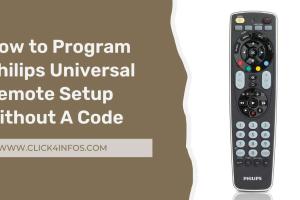Mastering Your Philips Universal Remote: Step-by-Step Programming Guide

-
Quick Links:
- Introduction
- Understanding Universal Remotes
- Philips Universal Remote Overview
- Programming Your Philips Universal Remote With Codes
- Programming Your Philips Universal Remote Without Codes
- Troubleshooting Tips
- Case Studies
- Expert Insights
- Conclusion
- FAQs
Introduction
In a world where remote controls are essential for our daily entertainment, the Philips Universal Remote stands out as a versatile tool that can simplify your life. This guide will delve into the intricacies of programming your Philips Universal Remote, both with and without codes, ensuring you can control all your devices with ease.
Understanding Universal Remotes
Universal remotes are designed to control multiple devices, such as TVs, DVD players, and sound systems. They eliminate the need for multiple remotes cluttering your living space. Philips Universal Remotes are particularly user-friendly and come equipped with features that make programming straightforward.
Philips Universal Remote Overview
Philips offers a range of universal remotes that adapt to various devices. This section will explore the most common models, their features, and how they can enhance your home entertainment experience.
Common Models
- Philips SRP501/27
- Philips SRP2004/27
- Philips SRP5018/27
Key Features
- Compatibility with multiple devices
- Easy programming options
- Ergonomic design
Programming Your Philips Universal Remote With Codes
Programming your Philips Universal Remote with codes is a straightforward process. Below, you will find a comprehensive guide to help you through the steps.
Finding the Right Codes
To program your remote, you will need specific codes for your devices. You can usually find these codes in the user manual that comes with your remote or online through the Philips support page.
Step-by-Step Guide: Programming with Codes
- Turn on the device you want to program (e.g., TV).
- Press and hold the 'Code Search' button until the red light turns on and then releases the button.
- Press and release the device button (TV, DVD, etc.). The red light blinks and then turns off.
- Enter the first code for your device. The red light will blink and turn off if the code is valid.
- Test the remote by pressing the power button. If the device turns off, programming is complete. If not, repeat the steps with the next code.
Programming Your Philips Universal Remote Without Codes
If you cannot find the codes for your device, you can program your remote without codes. This method involves a code search function.
Step-by-Step Guide: Programming without Codes
- Turn on the device you want to program.
- Press and hold the 'Code Search' button until the red light turns on and then releases the button.
- Press and release the device button (TV, DVD, etc.). The red light blinks and then turns off.
- Press and release the 'Power' button repeatedly until the device turns off. This may take several attempts.
- Once the device turns off, press the 'Enter' button to store the code. The red light will turn off.
Troubleshooting Tips
Sometimes programming a remote can lead to issues. Here are some common problems and solutions:
- If the remote does not control the device, ensure you have the correct code.
- Check the batteries in the remote to ensure they are functioning.
- Make sure there are no obstructions between the remote and the device.
Case Studies
To illustrate the effectiveness of programming a Philips Universal Remote, we present case studies from various users who have successfully programmed their devices.
Case Study 1: The Family Living Room
A family of four managed to program their Philips Universal Remote to control their TV, sound system, and streaming device, simplifying their entertainment setup.
Case Study 2: The Home Office
An individual set up their remote to control a projector and sound system for presentations, enhancing their home office efficiency.
Expert Insights
Experts recommend keeping your remote's user manual handy for troubleshooting and programming. Additionally, they suggest checking the Philips website for updates on device compatibility and new codes.
Conclusion
Programming your Philips Universal Remote can greatly enhance your home entertainment experience. By following the steps outlined in this guide, you can easily control multiple devices with ease, reducing clutter and improving accessibility.
FAQs
- 1. Can I program my Philips Universal Remote to control a smart TV?
- Yes, most Philips Universal Remotes can be programmed to control smart TVs, provided you have the correct codes.
- 2. What if I lost my remote's user manual?
- You can usually find a digital version of the manual on the Philips support website.
- 3. How do I reset my Philips Universal Remote?
- To reset, remove the batteries, press any button for 30 seconds, and then reinsert the batteries.
- 4. Does the remote work with all brands of devices?
- Most Philips Universal Remotes are compatible with a wide range of brands, but it’s best to check the manual for specifics.
- 5. Can I program my Philips remote to control my sound system?
- Yes, as long as you have the correct codes for your sound system.
- 6. How do I know if my remote is working properly?
- If the remote is not working, check the batteries and ensure you're within range of the device.
- 7. What should I do if the programming steps don’t work?
- Re-check the codes, ensure the device is on, and try the steps again. If issues persist, consult the manual.
- 8. Can I use my Philips Universal Remote for gaming consoles?
- Some Philips Universal Remotes are compatible with gaming consoles; check your manual for details.
- 9. Is there a limit to the number of devices I can program?
- This varies by model; refer to your user manual for specific limits.
- 10. What if my device does not respond after programming?
- Try reprogramming the device, ensuring you are using the correct code, and that the remote is functioning.
Random Reads